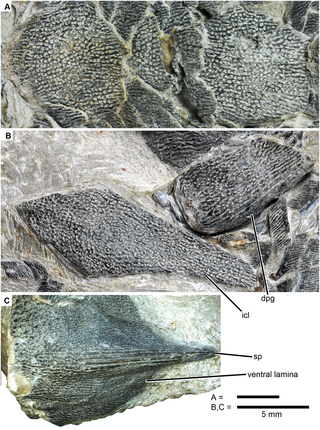Key: WFS,World Fossil Society,Riffin T Sajeev,Russel T Sajeev
An ancient fish species with unusual scales and teeth from the Kuanti Formation in southern China may have evolved prior to the “Age of Fish,” according to a study published March 8, 2017 in the open-access journal PLOS ONE by Brian Choo from Flinders University, Australia, and colleagues at the Institute of Vertebrate Paleontology and Paleoanthropology, China.

This is a holotype and interpretative reconstruction of Sparalepis tingi gen. et sp. nov.
Credit: Brian Choo: CCAL
The Devonian Period (419.2 — 358.9 million years ago) is popularly called the “Age of Fishes” because of the apparent increase in the abundance and variety of jawed fishes when compared with the preceding Silurian Period (443.7 — 419.2 million years ago). Until recently, the Silurian fossil record of jawed vertebrates has been based on highly fragmentary remains, limiting our understanding of their early evolution. Recent discoveries from the Kuanti Formation of Yunnan, southwestern China, have dramatically enhanced our knowledge, with several superbly preserved fish species described in recent years. The fish-bearing sediments of the Kuanti Formation have been dated to the latter part of the Silurian, about 423 million years ago.

Sparalepis tingi gen. et sp. nov., holotype V17915. Detailed images of median dorsal plates and appendicular skeleton.
A. 1st (left) and 2nd (right) median dorsal plates in dorsal view. B. interclavicle and right dermal pelvic girdle. C. left cleithrum in flattened ventrolateral view. Abbreviations: dpg, dermal pelvic girdle; icl, interclavicle; sp, pectoral fin spine.
Now, Choo and colleagues have described a new genus and species of Kuanti fish, Sparalepis tingi, which represents only the second Silurian bony fish based on more than isolated fragments. This new form, along with its contemporary Guiyu and the slightly more recent Psarolepis, possesses spine-bearing pectoral and pelvic girdles, features once thought to be restricted to the armored placoderm fishes. Sparalepis and its kin may represent an early radiation of stem-sarcopterygians, ancient cousins of modern lungfish, coelacanths and tetrapods.
![Scales of Sparalepis tingi gen. et sp. nov., holotype V17915. A. generalised reconstructed silhouette of Sparalepis showing scale zones based on the scheme of Esin [30]. B. Area A scales from the right flank. C. Area A scales from the left flank. D. Area B scale in anterolateral view. E. Area E scales. Abbreviations: l.a, anterior ledge; n.a, anterior notch.](http://www.worldfossilsociety.org/wp-content/uploads/2017/03/151209183454_1_540x360-1.png)
Scales of Sparalepis tingi gen. et sp. nov., holotype V17915.
A. generalised reconstructed silhouette of Sparalepis showing scale zones based on the scheme of Esin [30]. B. Area A scales from the right flank. C. Area A scales from the left flank. D. Area B scale in anterolateral view. E. Area E scales. Abbreviations: l.a, anterior ledge; n.a, anterior notch.

Life restoration of Sparalepis tingi (foreground) and other fauna from the Kuanti Formation.
Also in the scene are numerous conodont animals, a pair of the maxillate placoderm Entelognathus (middle distance) and two examples of the osteichthyan Megamastax (background), the largest known Silurian vertebrate. Illustration by Brian Choo, released under Creative Commons Attribution Licence CC BY 4.0, 2016.
http://dx.doi.org/10.1371/journal.pone.0170929.g009
Sparalepis adds to an ever-growing list of bizarre ancient fishes from the Silurian and earliest Devonian of Yunnan, suggesting that this region may have been an early center of diversification for the jawed vertebrates. The “Age of Fishes” appears to have arrived early during the Silurian of southern China.
Citation:Brian Choo, Min Zhu, Qingming Qu, Xiaobo Yu, Liantao Jia, Wenjin Zhao. A new osteichthyan from the late Silurian of Yunnan, China. PLOS ONE, 2017; 12 (3): e0170929 DOI: 10.1371/journal.pone.0170929
Key: WFS,World Fossil Society,Riffin T Sajeev,Russel T Sajeev



 March 10th, 2017
March 10th, 2017  Riffin
Riffin  Posted in
Posted in  Tags:
Tags: 